[ Home ] [ Controlled Substances ] [ Opioids ]
HEROIN
|
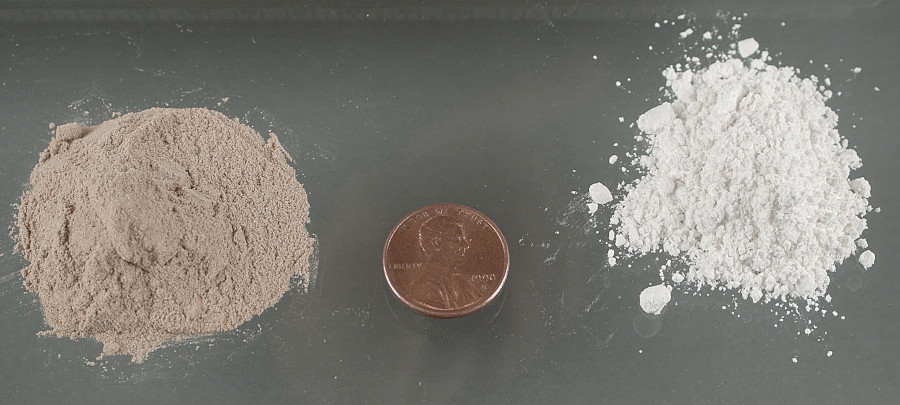
Heroin
Heroin is a highly addictive and rapidly acting opiate (a drug that is derived from opium). Specifically, heroin is produced from morphine, which is a principal component of opium. Opium is a naturally occurring substance that is extracted from the seedpod of the opium poppy.


https://www.justice.gov/archive/ndic/pubs3/3843/3843p.pdf
Heroin belongs to a group of pain-relieving drugs called narcotics. The drug comes from the opium poppy, a flower that grows in Asia, Mexico, and South America. Pure heroin has the consistency of white powder. Some heroin is also dark brown, while black tar heroin is either sticky or hard and looks like roofing tar. Although some narcotics like codeine and morphine are legal if prescribed for pain relief, heroin is an illegal narcotic because it has dangerous side effects and is very addictive. Heroin is usually injected or smoked. Heroin provides a burst or rush of good feelings, and users feel "high" and relaxed. This may be followed by drowsiness and nausea. Many people who are addicted to heroin inject the drug into a vein with needles, and may inject the drug several times a day. Over time, the needle marks, or tracks, can become permanent scars.
Sometimes Called:
horse, smack, big H, black tar, caballo (Spanish), 8-ball (heroin mixed with crack cocaine), junk, TNT

https://kidshealth.org/en/teens/heroin.html
Heroin comes in a white or brownish powder, or a black sticky substance known as "black tar heroin." Often "cut" with other drugs or substances such as sugar or powdered milk. User is unaware how much actual heroin is being used, creating likelihood of overdose. High purity heroin is usually snorted or smoked.

https://www.getsmartaboutdrugs.gov/drugs/heroin
Once heroin enters the brain, it is converted to morphine and binds rapidly to opioid receptors. People who use heroin typically report feeling a surge of pleasurable sensation - a "rush." The intensity of the rush is a function of how much drug is taken and how rapidly the drug enters the brain and binds to the opioid receptors. After the initial effects, users usually will be drowsy for several hours; mental function is clouded; heart function slows; and breathing is also severely slowed, sometimes enough to be life-threatening.
Repeated heroin use changes the physical structure13 and physiology of the brain, creating long-term imbalances in neuronal and hormonal systems that are not easily reversed. Studies have shown some deterioration of the brain's white matter due to heroin use, which may affect decision-making abilities, the ability to regulate behavior, and responses to stressful situations. Heroin also produces profound degrees of tolerance and physical dependence. Withdrawal may occur within a few hours after the last time the drug is taken. Heroin is extremely addictive no matter how it is administered, although routes of administration that allow it to reach the brain the fastest (i.e., injection and smoking) increase the risk of developing heroin use disorder.
Once a person has heroin use disorder, seeking and using the drug becomes their primary purpose in life.
Although heroin use in the general population is rather low, the numbers of people starting to use heroin have been steadily rising since 2007.

This may be due in part to a shift from misuse of prescription pain relievers to heroin as a readily available, cheaper alternative. Harmful health consequences resulting from the misuse of opioid medications that are prescribed for the treatment of pain, such as Oxycontin, Vicodin, and Demerol, have dramatically increased in recent years.
almost half of all opioid deaths in the U.S. now involve a prescription opioid.

https://www.drugabuse.gov/publications/research-reports/heroin/overview
Heroin use and overdose deaths have dramatically increased over the last decade. This increase is related to the growing number of people misusing prescription opioid pain relievers like OxyContin and Vicodin. Some people who become addicted to those drugs switch to heroin because it produces similar effects but is cheaper and easier to get.
In fact, most people who use heroin report they first misused prescription opioids, but it is a small percentage of people who switch to heroin. The numbers of people misusing prescription drugs is so high, that even a small percentage translates to hundreds of thousands of heroin users. Even so, some research suggests about one-third of heroin users in treatment simply started with heroin. Maybe they were mistakenly told that only one use cannot lead to addiction. Both heroin and opioid pill use can lead to addiction and overdose.
Heroin is mixed with water and injected with a needle. It can also be sniffed, smoked, or snorted. People who use heroin sometimes combine it with other drugs, such as alcohol or cocaine (a "speedball"), which can be particularly dangerous and raise the risk of overdose.
When heroin enters the brain, it attaches to molecules on cells known as opioid receptors. These receptors are located in many areas of the brain and body, especially areas involved in the perception of pain and pleasure, as well as a part of the brain that regulates breathing. Short-term effects of heroin include a rush of good feelings and clouded thinking. These effects can last for a few hours, and during this time people feel drowsy, and their heart rate and breathing slow down. When the drug wears off, people experience a depressed mood and often crave the drug to regain the good feelings. Regular heroin use changes the functioning of the brain.
Because heroin can slow and even stop breathing called a fatal overdose. Deaths from drug overdoses have been increasing since the early 1990s, fueled by increases in misuse of prescription opioids and, more recently, by a surge in heroin use.
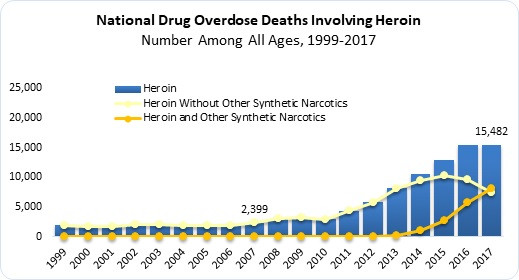
Heroin can be very addictive. It enters the brain quickly, causing a fast, intense high. Using heroin repeatedly can cause people to develop tolerance to the drug. This means they need to take more and more of it to get the same effect. Eventually they may need to keep taking the drug just to feel normal. When someone is addicted to heroin and stops using it, he or she may experience extremely uncomfortable and painful withdrawal symptoms, which is why it is so hard to quit.

https://teens.drugabuse.gov/drug-facts/heroin
Use of heroin nearly doubled between 2007 and 2012.
Drug experts say this is largely linked to growing abuse of prescribed painkillers such as OxyContin and Vicodin, which are also made from the poppy plant. People who misuse these drugs may be looking for a stronger, cheaper high. Heroin is both. But it's more dangerous. There's no way to know how strong what you're taking is or what it's mixed with. Sometimes it's laced with other drugs. Heroin overdose deaths doubled between 2010 and 2012. A spike in overdose deaths early in 2014 is believed to be linked to heroin laced with the powerful painkiller fentanyl.

https://www.webmd.com/mental-health/addiction/heroin-use#1
- From 2012 until 2015 heroin was the number one opioid killer due to overdose deaths as reported by the U.S. Centers for Disease and Control (CDC)
- Heroin is an opioid drug made from morphine, a natural substance taken from the seed pod of various opium poppy plants.
- Heroin can be a white or brown powder, or a black sticky substance known as black tar heroin.
- People inject, sniff, snort, or smoke heroin. Some people mix heroin with crack cocaine, called speedballing.
- Heroin enters the brain rapidly and binds to opioid receptors on cells located in many areas, especially those involved in feelings of pain and pleasure and in controlling heart rate, sleeping, and breathing.
- People who use heroin report feeling a "rush" (or euphoria). Other common effects include dry mouth, heavy feelings in the arms and legs, and clouded mental functioning.
- Long-term effects may include collapsed veins, infection of the heart lining and valves, abscesses, and lung complications.
- Research suggests that misuse of prescription opioid pain medicine is a risk factor for starting heroin use.
- A person can overdose on heroin. Naloxone is a medicine that can treat a heroin overdose when given right away, though more than one dose may be needed.
- Heroin can lead to addiction, a form of substance use disorder. Withdrawal symptoms include severe muscle and bone pain, sleep problems, diarrhea and vomiting, and severe heroin cravings.
- A range of treatments including medicines and behavioral therapies are effective in helping people stop heroin use. However, treatment plans should be individualized to meet the needs of the patient.
Heroin Factsheet:
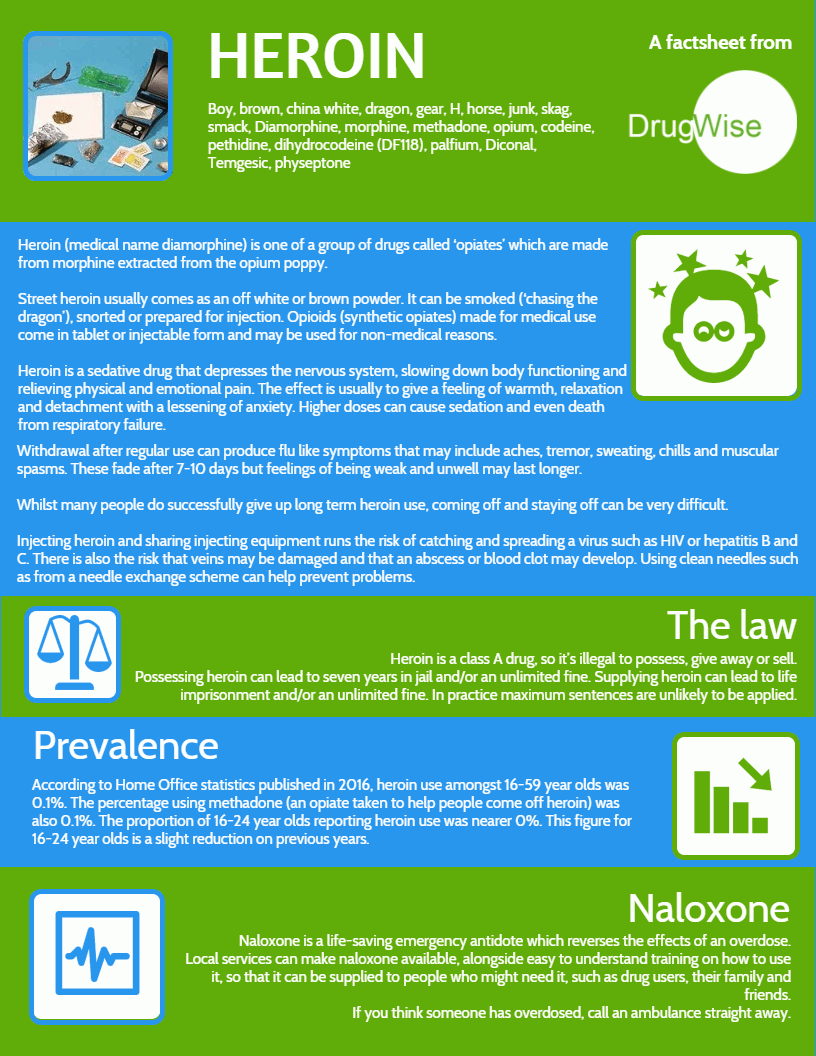

https://www.drugwise.org.uk/heroin/
History
The opium poppy has had a long history. Our earliest knowledge of its cultivation dates back to the ancient Mesopotamian and Sumerian cultures, who passed it on to the Assyrians, Babylonians, and Egyptians. The Greeks introduced opium to Persia and India, where it was grown in mass quantities. In the eighteenth century, the British began exporting it to China, where they traded it for tea. Opium abuse reached epic proportions in China, where millions of people became addicted in the 1800's. When the Chinese government tried to ban all opium imports in 1839, The First Opium War began, ending in the British taking Hong Kong. The Second Opium War of 1856 made opium imports into China legal again, still against the wishes of the Chinese government. Heroin was synthesized from morphine in 1874 by the pharmaceutical company Bayer and was touted as a safer, non-addictive form of morphine. It became a widely used drug in cough medicines and a variety of other ailments. By the beginning of the twentieth century, heroin was understood to be highly addictive and in 1914 was banned as part of the Harrison Narcotics Act.
Paraphernalia
Those who inject heroin use a set of paraphernalia that includes hypodermic needles, small cotton balls used to strain the drug, spoons or bottle caps for "cooking" (liquefying) the heroin, and a "tie-off" that the user wraps around his or her arm to make his or her veins protrude. Paraphernalia for sniffing or smoking heroin can include razor blades, straws, rolled dollar bills, and pipes. Also, balloons are used as a method of transporting and/or trafficking the drug.

http://www.cesar.umd.edu/cesar/drugs/heroin.asp
A vicious circle
During the 1850s, opium addiction was a major problem in the United States. The "solution" was to provide opium addicts with a less potent and supposedly "non-addictive" substitute - morphine. Morphine addiction soon became a bigger problem than opium addiction.
As with opium, the morphine problem was solved by another "non-addictive" substitute - heroin, which proved to be even more addictive than morphine.
With the heroin problem came yet another "non-addictive" substitute - the drug now known as methadone. The drug was soon being widely used as a treatment for heroin addiction. Unfortunately, it proved to be even more addictive than heroin.
By the late 1990s, the mortality rate of heroin addicts was estimated to be as high as twenty times greater than the rest of the population.


https://files.ondemandhosting.info/data/www.drugfreeworld.org/files/truth-about-heroin-booklet-en_en.pdf
Heroin is an opiate with strong sedative ('downer') and painkilling effects. It comes in powder form which varies in colour from brown to white. You can inject it, sniff it or smoke it on foil or in a tobacco-based joint. Effects can start quickly and last for several hours. This depends on how much of the drug you use and how you take it. Short term Makes you feel warm and relaxed with a hazy feeling of security. Longer term You build tolerance, so you need to take more to get the same buzz. Chronic constipation. Damage to veins if you inject it. Heroin is more dangerous when you use it with other depressant drugs such as alcohol, tranquillisers, benzos or other opiates, such as methadone
Your risk of overdose is particularly high if you stop using heroin for a while and then start using again as your tolerance goes down
Heroin is highly addictive, both physically and psychologically, so your body craves it and you feel you can't cope without it. If you use it regularly for 2 to 3 weeks you will build tolerance so you need to keep taking more to get the same buzz. You may start to experience withdrawal after several weeks on high, frequent doses of heroin. Withdrawals start 8-12 hours after your last use and include aches, shakes, sweating, chills, sneezing and yawning and muscle spasms. These fade after about a week and are not life threatening. A urine test will detect heroin for 3-8 days.

http://www.drugs.ie/drugtypes/drug/heroin
Heroin causes an intense and quick "high" when it is smoked, injected, or snorted. When you take heroin, it attaches to opioid receptors in the brain and causes a surge of dopamine, the chemical messenger that tells you when to feel pleasure. Heroin is also a central nervous system depressant, which means that it lowers body temperature and slows down breathing, heart rate, and blood pressure. Heroin can mellow a person out and make them feel sleepy, sluggish, and have a "heavy" feeling in their arms and legs. Heroin makes it hard to think straight or focus.
It is easy to overdose on heroin as it can overwhelm the body's systems very quickly and make it hard for a person to breathe.
Heroin significantly changes levels of important chemical messengers in the brain, and it doesn't take long for the brain to get used to these changes. A physical dependence on heroin can build up very fast, and when heroin processes out of the brain and the high wears off, intense and uncomfortable withdrawal symptoms and cravings can start.
Both heroin and alcohol have the same overall effects, as they are central nervous system depressant drugs. Regular use of both of these drugs affects other neurotransmitters, such as dopamine, by increasing its availability when reinforcing experiences are repeated. Because alcohol and heroin have similar overall effects, but primarily work on different neurotransmitter systems, using both drugs together enhances the effects of each drug and at the same time results in different sensations and experiences than using either drug alone.

https://www.alcohol.org/mixing-with/heroin/
1960s
The most popular form of treatment for heroin addiction was "Civil Commitment," which essentially placed heroin addicts in prison camps.
1970s
After use of heroin (and other drugs) skyrocketed, methadone was tested and found to be an effective treatment for opiate addiction. In the early 1970s, public concern over veterans returning from Vietnam with heroin addiction prompted the government to establish a nationwide network of methadone treatment clinics.
1980s
Heroin use was known to be associated with premature mortality, but the mechanisms were unknown. The emergence of AIDS gave new urgency to the need to treat heroin addicts, among whom HIV infection spread rampantly through the sharing of contaminated injection equipment.
TODAY
The discovery of opiate receptors by NIH-supported researchers, along with enkephalin and endorphins - the naturally occurring chemicals that bind to them - marked a watershed event in neuroscience for understanding the effects of drugs in the brain. We now have a much better understanding of the opioid system's role in regulating pain, mood, and other brain functions. Effective medications, including buprenorphine and methadone, along with HIV risk reduction interventions in intravenous drug abusers, have substantially reduced the proportion of new HIV/AIDS cases attributable to injection drug use. Currently, only about 20 percent of the estimated 810,000 heroin addicts seek or receive any form of treatment for their addiction. More than 200,000 people addicted to heroin pass through American correctional facilities each year. Opioid maintenance therapy can help this population

https://report.nih.gov/nihfactsheets/viewfactsheet.aspx?csid=123
Liver:
Persons who actively use heroin or opium often have liver disease due to substance abuse (alcoholic liver injury) or injection drug use (chronic hepatitis B, D or C), but neither heroin nor opium have been convincingly linked to clinically apparent liver injury or worsening of a concurrent liver disease.
Heroin Hepatotoxicity:
Despite centuries of use and abuse, opium and heroin have not been convincingly linked to cases of clinically apparent liver injury. Persons who use heroin or opium illicitly often have an underlying liver disease, due to other substance abuse behaviors (alcoholic liver disease) or parenteral exposures due to injection drug use (chronic hepatitis B, C or D). There is little evidence that opium or heroin use worsens these underlying liver diseases.E Likelihood score: E (unlikely cause of clinically apparent liver injury).
 Heroin Overview:
Heroin Overview:
https://www.ncbi.nlm.nih.gov/books/NBK548690/
Breastfeeding:Summary of Use During Lactation:
Heroin use during breastfeeding has not been systematically studied, but case reports indicate that infants exposed via breastmilk can be affected and develop abstinence if breastmilk is discontinued. Heroin use by breastfeeding mothers can also prevent symptoms of withdrawal in their heroin-exposed breastfed infants.Use of heroin as a street drug by nursing mothers carries the risk of breastmilk contamination with a variety of possible chemical contaminants that may be present in illicit heroin.
Heroin use by a nursing mother is generally considered to be a contraindication to breastfeeding.
Mothers who discontinue heroin use and begin methadone or buprenorphine maintenance therapy should be encouraged to breastfeed with ongoing medical support.Heroin (diamorphine) by the intrathecal or epidural route is recommended for analgesia during cesarean section and for postoperative analgesia in the United Kingdom where a standardized pharmaceutical product is commercially available. However, no research on the effect on the breastfed infant or lactation has been published with this use.
Drug Levels:
Heroin (diacetylmorphine) is rapidly metabolized in the body to 6-monoacetylmorphine, which is about 6 times more potent than Morphine; 6-monoacetylmorphine is further metabolized to morphine. All three drugs contribute to heroin's effects.Effects on Lactation and Breastmilk:
Heroin and morphine can increase serum prolactin.
However, the prolactin level in a mother with established lactation may not affect her ability to breastfeed.Alternate Drugs to Consider:
- (Analgesia) Acetaminophen
- Butorphanol
- Fentanyl
- Hydromorphone
- Ibuprofen
- Morphine
- (Opiate Dependency) Buprenorphine
- Methadone
- Naltrexone
 Heroin Drug Levels and Effects:
Heroin Drug Levels and Effects:
https://www.ncbi.nlm.nih.gov/books/NBK500783/
| Duration: A powerful opioid derived from Morphine, with 2-4x its potency. Infamous for a high addiction potential and fatal respiratory depression in overdose, C. R. Alder Wright first synthesised this compound in 1874 trying to find a less addictive alternative to Morphine. In recent years, it has often been sold cut with the extremely potent fentanyl, causing a spike in overdose deaths. NOTE: Heroin dose varies greatly depending on quality and tolerance. | |||
| Route | Onset | Duration | After Effects |
|---|---|---|---|
| Tripsit Factsheets | |||

Heroin Basic Information: http://drugs.tripsit.me/heroin | |||
| IV: | 0-5 minutes | 4-5 hours | 1-24 hours |
| Smoked: | 5-10 minutes | 3-5 hours | 1-24 hours |
| Insufflated: | 10-15 minutes | 3-6 hours | 1-24 hours |
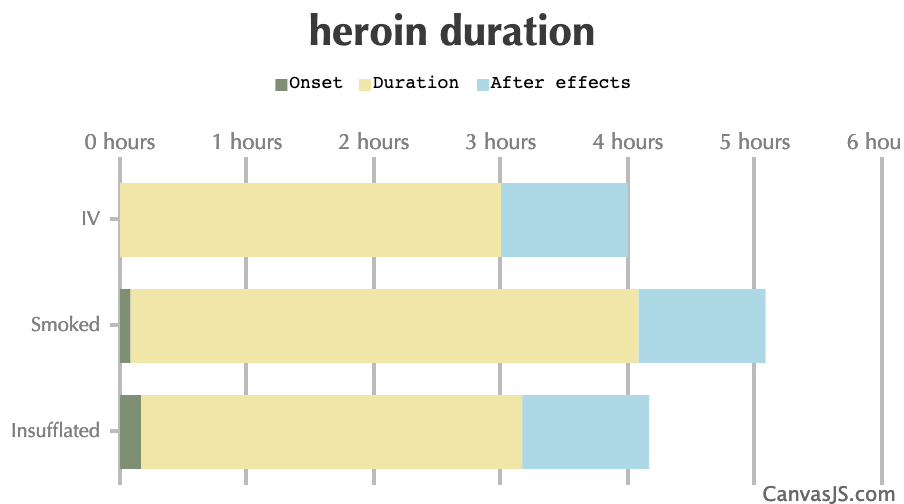
| |||
| Marquis: Deep purplish red | |||
| Half-life: 2-3 minutes | |||
| Effects: Euphoria, Dry Mouth, Mood lift, Itchiness, Relaxant, Constipation, Pupil Constriction, Analgesia. | |||

https://erowid.org/experiences/subs/exp_Heroin.shtml


http://www.drugpolicy.org/sites/default/files/heroinfacts_03_18_0.pdf
Q. IS IT TRUE THAT HEROIN ISN'T RISKY IF YOU SNORT OR SMOKE IT INSTEAD OF INJECTING IT?
A. NO. Heroin is very dangerous regardless of how it is used. While injecting drugs carries additional risk of infectious disease, taking heroin can be dangerous in any form. You can still die from an overdose or become addicted by snorting or smoking it. Heroin may also be mixed with synthetic opioids such as Fentanyl, which can be fatal in small doses regardless of how they are taken.


https://store.samhsa.gov/system/files/pep18-02.pdf
Addiction:Extent of use:
Heroin and opioid addiction is a treatable condition, but its use is increasing in recent years. The question is often asked, is prescription opioid use a risk factor for heroin use?But know that if you are using heroin, it doesn't really matter why or how you started. What is important is that you get help, now. There are thousands of substance abuse facilities in the US to access treatment for opioid use disorder. Seek advice from your health care provider who can guide you through the most appropriate and safe treatment regimen. Combined behavioral and medication therapies show the greatest success for heroin addiction.
- The opioid addiction epidemic may further fuel heroin use: research from the NIDA shows that after the year 2000 nearly 80% of users reported using prescription opioids before their first heroin use
- This is a shift from the 1960's: of those entering treatment for heroin addiction who began abusing opioids in the 1960s, more than 80% started with heroin
- Heroin is usually less expensive than prescription drugs bought on the streets, as well. Plus, the crackdown on prescription opioid prescribing may lower the availability of these drugs for illegal use, boosting the sale of heroin
- In 2015, a study published by Jones and colleagues found that misuse or dependence on prescription opioids was been associated with a 40-fold increased risk of dependence on or abuse of heroin
- However, while prescription opioid misuse is a risk factor for starting heroin use, only a small fraction of people who misuse pain relievers switch to heroin, as reported by the NIDA. According to a national survey, less than 4% of people who had misused prescription pain medicines started using heroin within 5 years
 Heroin Drug Information:
Heroin Drug Information:
https://www.drugs.com/illicit/heroin.html
Heroin addiction is a complex condition, with numerous social, psychological, and physical causes and effects. Despite people with heroin addiction being on the receiving end of some of the worst social stigma, heroin addiction does not make you a bad person, even if you behave in ways you later regret. Many people who have been addicted to heroin have been able to stabilize their lives, often with the help of treatment, and may even go on to help others.

https://www.verywellmind.com/heroin-4157307
Pregnancy:
If you use heroin during pregnancy, it can cause serious problems for your baby, like premature birth, NAS, birth defects and stillbirth.

https://www.marchofdimes.org/pregnancy/heroin-and-pregnancy.aspx

https://medlineplus.gov/ency/article/002861.htm

https://medlineplus.gov/ency/article/000949.htm

https://www.cdc.gov/drugoverdose/opioids/heroin.html
Giving up heroin after using it for a long time is challenging because the body has to get used to functioning without it.


https://cdn.adf.org.au/media/documents/Heroin-Fact-sheet-FINAL.pdf
Generally considered to be the worst, most addictive and dangerous of all the predominant recreational drugs.
Heroin is horrible and deadly. Believe me, please. I know what I'm saying, don't think that it's cool.

https://drugs-forum.com/forums/heroin.123/

https://www.reddit.com/r/heroin/


https://www.drugabuse.gov/sites/default/files/heroinrrs_11_14.pdf


https://ndarc.med.unsw.edu.au/sites/default/files/ndarc/resources/NDA073%20Fact%20Sheet%20Heroin.pdf

https://www.health.gov.au/internet/drugstrategy/publishing.nsf/Content/9011C92D2F6E1FC5CA2575B4001353B6/$File/bupren4.pdf
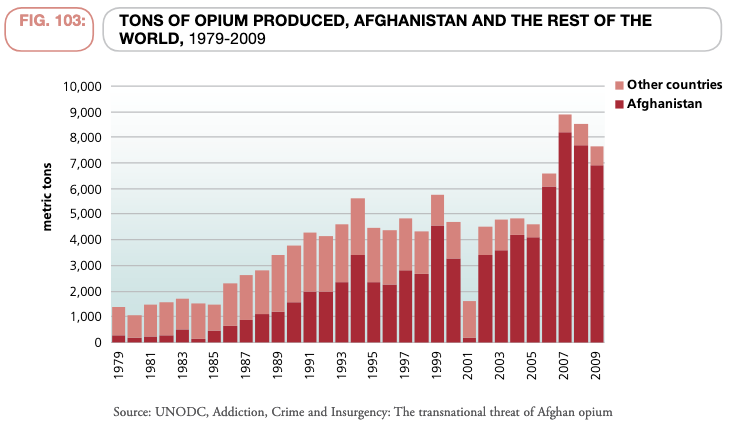


https://www.unodc.org/documents/data-and-analysis/tocta/5.Heroin.pdf
Heroin:
Treatment of heroin addiction often includes behavioral therapy and medications. Medications can include buprenorphine, methadone, or naltrexone. A heroin overdose may be treated with naloxone.
- An opioid
- Used as a recreational drug for its euphoric effects
- It is typically injected, usually into a vein, but it can also be smoked, snorted, or inhaled.
- The onset of effects is usually rapid and lasts for a few hours.
- Common side effects include respiratory depression (decreased breathing), dry mouth, drowsiness, impaired mental function, constipation, and addiction.
- Side effects of use by injection can include abscesses, infected heart valves, blood-borne infections, and pneumonia.
- When given by injection into a vein, heroin has two to three times the effect of a similar dose of morphine
- It typically comes as a white or brown powder.
- It was first made by in 1874 from morphine, a natural product of the opium poppy.
About 448 tons of heroin were made in 2016. In 2015, Afghanistan produced about 66% of the world's opium. Illegal heroin is often mixed with other substances such as sugar, starch, caffeine, quinine, or other opioids like fentanyl.
Diamorphine is used medically in several countries to relieve pain, such as during childbirth or a heart attack, as well as in opioid replacement therapy. In a clinical context the route of administration is most commonly intravenous injection; it may also be given by intramuscular or subcutaneous injection, as well as orally in the form of tablets
After a history of long-term use, opioid withdrawal symptoms can begin within hours of the last use.
Warning over heroin use after near-fatal cases - Drug users who have recently used heroin should seek urgent medical advice, the Isle of Man Constabulary has said. It follows two incidents of “near-fatal overdoses” that were attended to by police ... Monday April 15, 2024 - msn.com Felon Who Sold Fentanyl, Meth, Heroin in Cherry Valley Headed to Prison - A convicted felon who stored thousands of fentanyl pills, as well as large quantities of methamphetamine and heroin, for sale out of his Cherry Valley home was bound for state prison Tuesday to serve ... Police find 9 kilos of heroin on Amtrak train in Rocky Mount - ROCKY MOUNT, N.C. (WITN) - An Eastern Carolina police department says they seized more than 9 kilos of heroin on an Amtrack train on Friday. Rocky Mount police say Keith Haskins was charged with two ... Cleveland gang member sentenced to 15 years in prison for supplying drugs to rival gang - Devin Long, 23, was sentenced to 15 years in prison for supplying a range of drugs to street-level dealers in Cleveland, including a member of the Heartless Felons, a rival street gang. Drug dealer used man's death to advertise potency of drugs he sold in Facebook group, DOJ says - The United States Attorney's Office said that evidence introduced at trial and sentencing showed that on Nov. 18, 2021, Earwood mailed a package of heroin and fentanyl to the victim. Earwood was ... Houston Police Seize 45 Kilos of Meth, Heroin, and AK47-Style Rifle in Major Drug Bust - Houston Police, with other agencies, dismantled a meth lab, seizing 45 kilos of meth, heroin, and an AK47-style rifle, highlighting the city's drug crisis. Major Drug and Gun Trafficking Operation Busted in Ocean County - A comprehensive four-month investigation led by the Narcotics Strike Force, alongside the United States Drug Enforcement Administration – ... Bond increased for Amtrak mule caught bringing 20 lbs. of heroin into Rocky Mount, police say - The man caught with 20 pounds of heroin worth $400,000 was bringing it into Rocky Mount on an Amtrak train, police said ... UCSO investigation results in two drug-trafficking arrests - A Union County Sheriff's Office (UCSO) narcotics investigation resulted in the arrest of two people on drug-trafficking and weapons charges. Here comes an illicit drug 40 times more potent than fentanyl - Nitazene first appeared in 2019 in the Midwest as a white powdery substance similar to cocaine. It later appeared on the streets of Washington, D.C., as yellow, brown and white powders. Since 2022, ... 7 kg heroin, Rs 36 lakh drug money seized - In a major haul of drugs along with arms and ammunition ahead of the Lok Sabha election, the sleuths from Crime Investigation Agency (CIA) have nabbed ... Notorious drug trafficker nabbed in STF raid - A notorious, 33-year-old drug trafficker was yesterday (16) arrested with 526 grams of Ice narcotics in his possession, by the Police ...
| ||
| Opioids | Link to this page |








